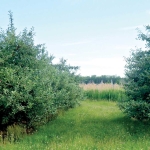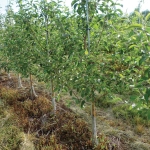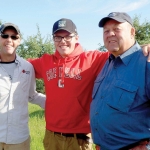Driving east across Wayne County in northwestern New York State, just inland from Lake Ontario on the left, one is not surprised by the number of apple orchards. This is definitely apple country.
What is surprising is the size and spacing of the trees in so many orchards. While growers there describe themselves as “in transition,” the newer high-density orchards of modern fresh market varieties are like salt and pepper sprinkled among the meat and potatoes of older blocks of apples that will go to processing.
Cornell University held its Lake Ontario Summer Fruit Tour in Wayne County in mid-June, and the goal was to show the “salt and pepper” and what growers are doing with new plantings to the 160 growers who attended. But all the orchards Good Fruit Grower visited on the tour were still heavy to varieties that go mainly for processing.
One of those is Windmill Farms near Ontario, New York, where Bob Coene and his son Dave grow 300 acres of apples. Grandson Tom, 17, hopes to be the fifth generation to farm the land.
They began transitioning to newer orchards and trellis systems 15 years ago, but they are far from finished.
Bob says that only 30 to 40 percent of their apples go to packing plants for fresh sale, and most go to Mott’s for apple sauce and juice or are shipped to Peterson Farms, 600 miles west in Michigan, for a premium processing market in fresh apple slices. Peterson has a huge slice of the McDonald Happy Meals market.
“Processing economics is not good,” Coene agreed. “It’s hard to produce apples for 10 and 11 cents a pound.”
Still, he said, practically speaking, there are not enough trees or money to convert all the old orchards over to new ones in a short time frame. It is taking, and will take, years. The biggest factor when deciding to push out an older orchard is orchard age and, secondarily, how desirable the variety is for processing, he said.
Just as consumer choices change in fresh market, processor choices evolve as well, and when a processor no longer wants a variety, and the fresh market doesn’t want it either, the alternatives are abandon it, push it, or juice it.
Processing advantages
While a processing block may produce 450 bushels per acre compared to 1,000 for Honeycrisp, and sell for 12 cents a pound instead of $1.25, the processing block has some things going for it, Coene said.
The biggest advantage is, it is older and paid for. Trees were planted at a low density, 450 per acre, without supporting trellis or irrigation. So the initial investment was relatively low.
While apples on the bigger trees may not size as well or color as uniformly, the pruning and thinning costs are lower. The spray bills can be somewhat lower if the grower knows the block is being grown for processing. Copper and older, cheaper protectant products can be used as fungicides, for example, since apple finish is less important.
And the processing plant is a great rescue market in years of hail damage or apple scab epidemics.
There are no packing charges if a grower decides to take a load of apples, field-run, to a processing plant. So growers who have dual-purpose varieties can choose not to invest further money in lots that won’t pack out well.
The Coenes also own no storages. They sell everything from the field each fall.
While the Coenes have been in transition for some time, the transition choices they are making show their intentions. They are moving to high-value, fresh-market varieties.
At one time, Coene said, Windmill Farms did some direct marketing and was known locally for its excellent sweet cider.
“Twelve years ago, we had a seasonal farm market, selling just our own fruit,” he said. “But it was evident that modern retail markets needed to offer more—not just more products but entertainment.”
And, he said, running a retail market got to be a burden, especially as he got older. “Honeycrisp also came along and forever changed the apple industry—it was so unique, so good.”
So then they began the transition—abandoning cherries and peaches and focusing on growing better apples for fresh market. The processing market was there to help them. No way were they going to push all the old trees and invest in a complete changeover.
Today, they have invested in high-density, tall-spindle orchards planted to New York 1 (SnapDragon), Gala, Fuji, and Honeycrisp, mostly on a 3- by 13-foot spacing and M.9 rootstocks, about 1,100 trees per acre.
They have invested in fencing to keep deer out. “We’ve struggled with deer pressure the last 10 years,” Dave Coene said. “We’ve used nuisance permits, dryer sheets, soaps, and repellents, but it was obvious we needed to fence our orchards or lose them,” he said.
Three years ago, they built a “one-sided fence,” trying to wall off the side where deer pressure was greatest. The deer learned quickly to walk around the ends, so they added two more sides. That didn’t work, either, so now blocks are completely enclosed.
Since it is much cheaper per foot to fence large blocks than small ones, the goal is to fence a large area and not just individual blocks as they are planted.
Dave Coene is also convinced “the future is in some kind of club variety. We’ve planted quite a few SnapDragon.” It is important that supply be restricted to the size of the market, he said.
The thing that killed Empire as a variety, he said, was supply became too large and the price declined. Otherwise, it was a good apple. Many growers fear the same fate for Honeycrisp. •









Leave A Comment